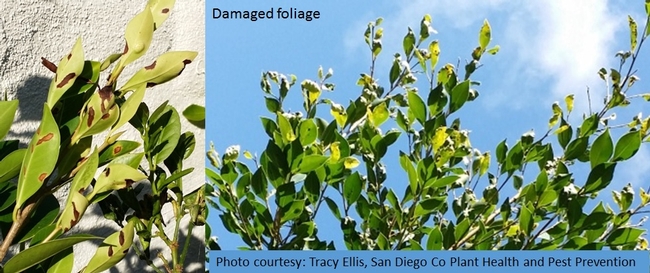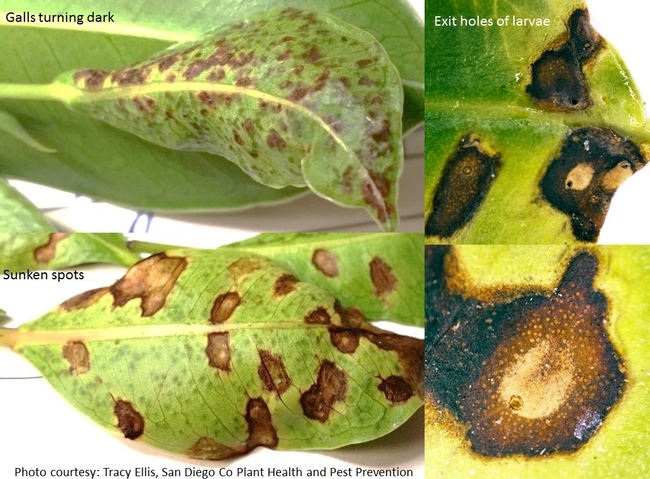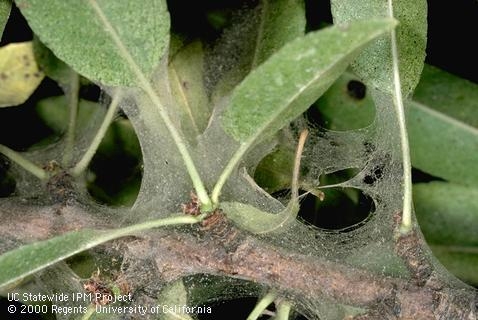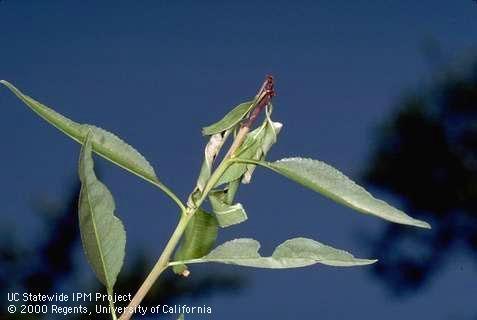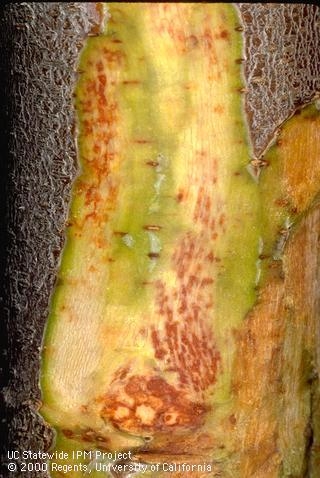- Author: Cheryl Reynolds
- Author: Petr Kosina
Whether or not your favorite team is playing in Sunday's big game, the Super Bowl is often a great excuse to gather with friends and family and enjoy some tasty treats! Maybe your favorite snack involves chips with salsa or guacamole, or perhaps you prefer shrimp with a delicious avocado dip. Whatever your snack of choice, chances are that you might spice it up with a little cilantro or parsley.
Cilantro and parsley growers have something else to be happy about – The UC Statewide IPM Program just released new Pest Management Guidelines for Cilantro and Parsley.
Cilantro and parsley are herbs used both fresh and dry for preparation of many popular dishes in almost all parts of the world including California. Apart from their pleasant flavor, both plants are also known for a number of nutritional and health benefits.
In California, cilantro and parsley are grown commercially on more than 7,000 acres, primarily along the southern and central coast. Cilantro (also known as Chinese or Mexican parsley) and parsley are examples of specialty vegetable crops important in crop rotations and in contributing to California's overall agricultural diversity.
Although pest problems aren't too common for home gardeners growing cilantro or parsley, for commercial growers, crop damage due to insect pests and diseases may be devastating and cause important economic losses. The new UC IPM Pest Management Guidelines for cilantro and parsley provide pest and management information for insects pests (including beet armyworm, cabbage looper, and aphids), diseases (including apium virus Y, bacterial leaf spot, carrot motley dwarf, cilantro yellow blotch, Fusarium wilt, and septoria leaf spot), and nematodes. Because weed management costs can be very high in cilantro and parsley unless weed control programs are carefully planned and implemented, a comprehensive weed management section is also included.
Check out the new guidelines and other pest management information on the UC IPM website.
- Author: Cheryl Reynolds
Are you looking for continuing education units (CEUs) to complete your renewal application this year for the Department of Pesticide Regulation (DPR)? The UC Statewide IPM Program has several online courses available that can help you get those last few needed credits.
DPR license and certificate holders with last names beginning with M – Z renew this year. Renewal packets must be submitted to DPR before November 19th to ensure that licenses are renewed by January 1, 2016. After that, applications may take up to 45 calendar days to process.
The online courses available from UC IPM that offer units for DPR license renewal include:
- Providing Integrated Pest Management Services in Schools and Child Care Settings (1 unit Laws and Regulations and 1 unit Other)
- Pesticide Resistance (2 units Other)
- Pesticide Application Equipment and Calibration (1.5 units Other)
- IPM – A Solution for Reducing Pesticides/Water Quality: Pesticide Properties (1 unit Other)
- The Impact of Pesticides on Water Quality/Mitigating Urban Pesticide Runoff (1 unit Other)
- Water Quality and Mitigation: Bifenthrin and Fipronil (1 unit Other)
- Herbicides and Water Quality (1 unit Other)
CEUs from the Structural Pest Control Board are also available for most of these courses.
For a list of other approved online or in-person courses, visit the DPR website. UC IPM plans to add additional online courses for 2016, including those available for Laws and Regulations units. For more information about the courses UC IPM offers as well as additional training opportunities and pest management information, see the UC IPM web site.
- Author: Surendra K. Dara
Deformed and yellowing foliage of Indian laurel fig infested with the ficus eye-spot midge. Photo: Tracy Ellis.
San Diego County entomologist, Tracy Ellis recently reported the occurrence of a small gall midge in Rancho Santa Fe and La Jolla. Established populations of the ficus eye-spot midge, Horidiplosis ficifolii Harris & de Goffau 2003 (Diptera: Cecidomyiidae) were found in Indian laurel fig (Ficus microcarpa var. nitida) in late 2014. Early last year, another exotic pest, weeping fig thrips (Gynaikothrips uzeli) was found infesting weeping fig (F. benjamina).
Origin and Distribution: Eye-spot midge is native to South East Asia. It was first described from the infestations in weeping fig imported from Taiwan to the Netherlands which later moved to UK. Galls collected in UK and larvae and adults reared in Denmark and the Netherlands were used to describe the pest. Eye-spot midge was later reported in Italy in 2007, USA (Florida) in 2008, and the Czech Republic in 2010.
Host range: It appears to be a primary pest of ornamental figs hence the specific name ficicolii which means 'of fig leaves'. In California, Florida and the Czech Republic, eye-spot midge was found on the Indian laurel fig, in Denmark, UK, and the Netherlands on the weeping fig, and in Italy on a host referred to as ornamental fig.
Damage: Larvae form galls on young leaves. Galls are irregularly shaped and about 4 mm in diameter. When larvae exit the galls for pupation, galls collapse and become dark brown, sunken spots that could be mistaken for leaf spots caused by bacterial or fungal diseases. Circular exit holes of 1-2 mm diameter can be seen on older galls. Heavy infestations could lead to leaf fall.
Mature galls turning into dark, sunken spots. Round holes formed by larvae exiting the galls. Photo: Tracy Ellis.
Biology: Information on eggs is lacking, but they are probably deposited on foliage. Young larvae are translucent and about 1 mm long. They make galls and develop individually inside each gall. Mature larvae are bright orange and up to 2 mm long. Mature larva exits the galls to pupae in the soil or other substrates. Adults are small midges with brownish orange bodies and are weak fliers. Wings do not have any markings and are 1.6 mm long in males and 2 mm in females. Life cycle is completed in about one month at 20oC or 68oF.
Ficus eye-spot midge life stages. Photo: Tracy Ellis.
Management: There are no specific management options reported in any literature except for the removal and destruction of the infested foliage.
What to do: If you suspect ficus eye-spot midge infestations, please inform your local Ag Commissioner or University of California Cooperative Extension office.
http://ucanr.edu/articlefeedback
References
Beránek J. and I. Šafránková I. 2010. First Record of Horidiplosis ficifolii Harris 2003 (Diptera: Cecidomyiidae) in the Czech Republic. Plant Protect. Sci. 46: 189–191.
Caldwell. D. 2012. Ficus trees under attack! https://palmbeachcountyextension.files.wordpress.com/2012/01/ficus-trees-under-attack.pdf
Harris K.M. and L.J.W. De Goffau. 2003. Horidiplosis ficifolii, a new species of gall midge (Diptera: Cecidomyiidae) damaging ornamental fig plants, Ficus benjamina L. Tijdschr. Ent. 146: 301–306.
Steck G.J. and S. Krueger. 2008. An ornamental fig pest, Horidiplosis ficifolii Harris (Diptera: Cecidomyiidae), genus and species new to Florida and North America. http://www.freshfromflorida.com/Divisions-Offices/Plant-Industry/Plant-Industry-Publications/Pest-Alerts/Pest-Alerts-An-Ornamental-Fig-Pest-Horidiplosis-Ficifolii-Harris-Diptera-Cecidomyiidae
Suma P., A. Russo A. and S. Longo. 2007. Horidiplosis ficifolii (Diptera Cecidomyiidae) infestante su Ficus ornamentali in Sicilia. In: Proceeding XXI Congresso nazionale italiano di Entomologia, Catania 10–15 Giugno: 230.
Taxonomic description on Fauna Europaea http://www.faunaeur.org/full_results.php?id=303211
van der Gaag, D. J., E. Dijkstra, W. Lammers, A. Meijer, and E. J. Scholte. 2006. Pest risk analysis: Horidiplosis ficifolii Harris. https://www.nvwa.nl/txmpub/files/?p_file_id=2000933
- Author: Cheryl Reynolds
Spider mites, fruit moth and twig borer larvae, aphids, and bark cankers are just a few pests that can wreak havoc on stone fruit trees. With spring well underway and trees in full bloom and beginning to develop fruit, it's time to monitor and take action before these pests get out of hand.
UC IPM teamed up with UC farm advisors to develop a series of how-to videos that can help growers and pest control advisers monitor for pests and damage and determine if and when treatment is needed.
In one video, Sacramento Area IPM Advisor Emily Symmes gives a brief overview of how to monitor for webspinning spider mites. Spider mites build up in stone fruit trees as the weather warms up. Late spring through summer is the ideal time to monitor for mites and their damage, which includes leaf stippling and webbing. If mites build up too much, leaves can drop, fruit may not fully develop, and branches and fruit can be exposed to sunburn.
Shoot strikes, or dead drooping leaf tips, are often seen on young peach and nectarine trees. In a second video, UC Sutter and Yuba County Farm Advisor Janine Hasey explains how to monitor for shoot strikes and how to distinguish the culprits, oriental fruit moth and peach twig borer. Although Oriental fruit moth and peach twig borer can bore into both foliage and fruit, they cause the most devastating damage by feeding on fruit. Early season monitoring and treatment can prevent future fruit loss.
In plum and prune orchards, leaf curl aphids and mealy plum aphids cause leaves to curl and become distorted. Aphids produce honeydew, which can lead to the development of sooty mold, causing fruit to crack and blacken. Aphids are often present when leaves start to grow. In his video, Rick Buchner, UC farm advisor for Tehama County, discusses how to monitor for aphids and explains how to decide when treatment is warranted.
In a final video, UC Sacramento County Farm Advisor Chuck Ingels teaches how to distinguish Phytophthora root and crown rot from bacterial canker. The two diseases are often confused because they both cause bark cankers. Phytophthora root and crown rot is confined to the lower trunk, but when a bacterial canker infection occurs in the tree trunk, the diseases can often be confused. Bacterial canker can be confirmed by cutting away the outer bark and looking for characteristic red flecks on the inner bark. Correct identification of these diseases will help in choosing a management strategy.
You can find all of these how-to videos on the UC IPM video library page. For specific information about managing pests in stone fruits or other crops, see the Pest Management Guidelines.
- Author: Surendra K. Dara
Adult spotted lanternfly (Lycorma delicatula). Source http://hojae.net/520.
The Pennsylvania Department of Agriculture recently reported the first detection of yet another invasive hemipteran pest in the US. While efforts to have a good grip over other invasive hemipterans like the Asian citrus psyllid, the Bagrada bug, and the brown marmorated stink bug is still underway, there is a new pest that could potentially impact industries ranging from lumber to wine.
An exotic pest known as the spotted lanternfly, Lycorma delicatula (White) was recently detected in Berks County, PA. Spotted lanternfly, which is actually not a fly, but a planthopper is also referred to as “spot clothing wax cicada” or “Chinese blistering cicada” in the literature. It belongs to the family Fulgoridae in the order Hemiptera. Fulgorids or members of the family Fulgoridae are moderate to large planthoppers generally referred to as lanternflies because of the inflated front portion of the head that was thought to be luminous. Spotted lanternfly is regarded as a poisonous insect in Chinese medicine and used for relief from swelling.
Origin and distribution
Spotted lanternfly is native to China and is present in Southeast Asia. It was first reported in South Korea in 2006 and rapidly spread to different parts of the country.
Host range
Spotted lanternfly feeds on a variety of host plants including fruit trees, ornamental trees, woody trees, and vines. Apples, birch, cherry, dogwood, grapes, Korean Evodia, lilac, maple, poplar, stone fruits, and tree-of-heaven are among more than 70 species of hosts attacked by this pest. Tree-of-heaven, which contains high concentrations of cytotoxic alkaloids, is one of the favorite hosts. This is probably why spotted lanternfly is considered poisonous and used in traditional Chinese medicine. Other preferred hosts such as Korean Evodia (Bebe tree) are also used in oriental medicine suggesting that spotted lanternfly has a high preference for hosts that contain toxic secondary metabolites. Observations in South Korea also indicate that spotted lanternfly appears to have a wider host range early in life as young nymphs and a narrow range as they grow older, especially before egg laying. Choosing plants with toxic metabolites for egg laying is thought to be a mechanism of defense to protect from natural enemies. Although grape vine does not have toxic metabolites like these other hosts, spotted lanternfly showed a strong preference in studies conducted in South Korea. Sugar content of the host plant also appears to play a role in their choice with a preference for hosts containing high sucrose and fructose content.
Biology
Eggs are laid on tree trunks in ootheca (egg case) in groups of 30-50 and are covered in a yellowish brown waxy deposit. Eggs usually hatch during the early hours of the day. Waxy deposit disappears on old egg masses which look like brown seeds. There are four nymphal instars. Nymphs have a black body. The first three instars have white spots while the fourth instar has red wing pads and upper body. Nymphs start climbing up the trees after they emerge and fall off when there is a physical obstacle or disturbance from wind or other factors and start climbing up again. This falling and ascending cycle is thought to be a means of host selection and dispersal. Adult males are 20.5-22 mm (0.81-0.87 inches) long from head to the end of the folded wing and females are 24-26.5 mm (0.94-1.04 inches) long. Forewings are greyish with black spots in different patterns. Part of the hind wing is red with black spots and the rest is white and black. Tips of the wings show a network of veins (reticulated). Abdomen is yellowish with black bands. Legs are black and have white spots during nymphal stages. Length of the legs varies from 15-18 mm (0.59-0.71 inches) in adult males and 18-22 mm (0.71-0.87 inches) in adult females. Adults are weak flyers, but good hoppers. Head is black with piercing and sucking mouthparts. Life cycle is typically univoltine (one generation per year) and spotted lanternfly overwinters as eggs.
Damage
Adults and nymphs feed on phloem tissues of foliage and young stems with their piercing and sucking mouthparts and excrete large quantities of liquid. Due to the sugar content of the liquid, plant parts covered with spotted lanternfly excretion harbor mold growth, which could hinder plant growth or even cause death.
Management
Neonicotinoids, pyrethrins, and organophosphates are among the chemical insecticides effective against spotted lanternfly. Adults and 2nd-4th instar nymphs appear to be attracted to spearmint oil which could be used in their control. Using sticky traps at the base of the tree trunks also appears to be a good management strategy. Parasitic wasp, Anastatus orientalis is reported to parasitize up to 69% of spotted lanternfly eggs in China. This egg parasitoid is considered a potential biocontrol agent for release against the spotted lanternfly in South Korea.
What to do if you find this insect
Please contact your local agricultural department, Agricultural Commissioner's office (if you are in California), or agricultural extension office to report the infestation if you have to report the pest infestation in a new area or you need specific information on how to manage the infestation.
Photos of the pest
Pictures of the spotted lanternfly can be found at the following sources:
Adults: http://hojae.net/520
Fourth instar nymph: https://www.flickr.com/photos/itchydogimages/6984394006/in/pool-lanternbugs
Early instar nymphs: https://www.flickr.com/photos/itchydogimages/6197213287/
http://ucanr.edu/articlefeedback
References
Barringer, L. 2014. Pest alert: Spotted lanternfly, Lycorma delicatula (White) (Hemiptera: Fulgoridae). Pennsylvania Department of Agriculture.
Choi, M.-Y., Z.-Q. Yang, X.-Y. Wang, Y.-L. Tang, Z.-R. Hou. 2014. Parasitism rate of egg parasitoid Anastatus orientalis (Hymenoptera: Eupelmidae) on Lycorma delicatula (Hemiptera: Fulgoridae) in China. Korean J. Appl. Entomol. 53: 135-139.
Ding J., Y. Wu, H. Zheng, W. Fu, R. Reardon, and M. Liu. 2006. Assessing potential biological
control of the invasive plant, tree-of-heaven, Ailanthus altissima. Biocontrol Sci. Technol. 16:547-566
Han, J. M., H. Kim, E. J. Lim, S. Lee, Y.-J. Kwon, and S. Cho. 2008. Lycorma delicatula (Hemiptera: Auchenorrhyncha: Fulgoridae: Aphaeninae) finally, but suddenly arrived in Korea. Entomol. Res. 38: 281-286.
Kim, J. G., E.-H. Lee, Y.-M. Seo, and N.-Y. Kim. 2011. Cyclic behavior of Lycorma delicatula (Insecta: Hemiptera: Fulgoridae) on host plants. J. Insect Behav. 24: 423-435.
Frantsevich L., A. Ji, Z. Dai, J. Wang, L. Frantsevich, and S. N. Gorb. 2008. Adhesive properties of the arolium of a lantern-fly, Lycorma delicatula (Auchenorrhyncha, Fulgoridae). J. Insect Physiol 54: 818– 827.
Lee, J.-E., S.-R. Moon, H.-G. Ahn, S.-R. Cho, J.-O. Yang, C. Yoon, and G.-H. Kim. 2009. Feeding behavior of Lycorma delicatula (Hemiptera: Fulgoridae) and response on feeding stimulants of some plants. Korean J. Appl. Entomol. 48: 467-477
Moon. S.-R., S.-R. Cho, J.-W. Jeong, Y.-H. Shin, J.-O. Yang, K.-S. Ahn, C. Yoon, and G.H. Kim. 2011. Attraction response of spot clothing wax cicada, Lycorma delicatula (Hemiptera: Fulgoridae) to spearmint oil. Korean Soc. Appl. Biol. Chem. 54: 558-567.


